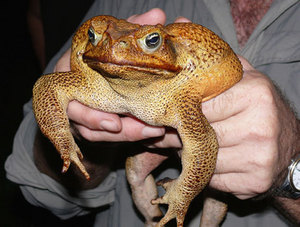
|
| ©Getty Images |
| Monster Toad |
Mark Twain told tall tales about fantastic frogs, but a "monster" toad caught yesterday in Australia might have given the author a run for his money.
Volunteers found the football-size cane toad in a pond near the northern port city of Darwin (see Australia map).
Nearly 15 inches (38 centimeters) long and weighing about 2 pounds (0.9 kilogram), the croaker is one of the largest specimens ever caught in Australia.
"It's huge, to put it mildly," Graeme Sawyer, coordinator of the group that caught the toad, told the Associated Press. "The biggest toads are usually females, but this one was a rampant male. ... I would hate to meet his big sister."
Sawyer's group was "raiding" Darwin's ponds last night as part of its mission to correct what some see as Australia's biggest environmental blunder: the introduction of the poisonous cane toads in the 1930s.
The toads were imported from South America to eradicate scarab beetles that were feasting on sugar cane crops. But soon it was the toads that were the pests, causing the deaths of countless native animals that eat them, from snakes to crocodiles.
Today groups like Sawyer's conduct regular excursions to capture the toads, which are then killed with carbon dioxide gas, frozen, and processed to neutralize the toxins.
"It turns out to be sensational fertilizer," Sawyer said of the resulting by-product.
But evidence suggests that the toads may be staying one jump ahead. A study last year found that the toads now cover five times more ground annually than they did in the 1930s - in part because they have evolved longer legs.



Reader Comments
to our Newsletter